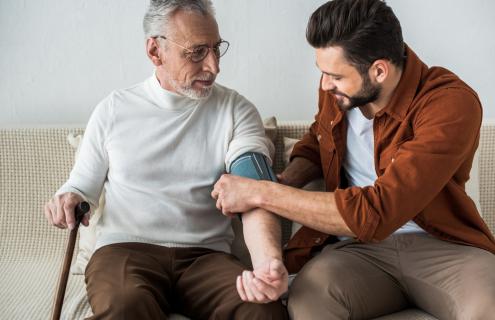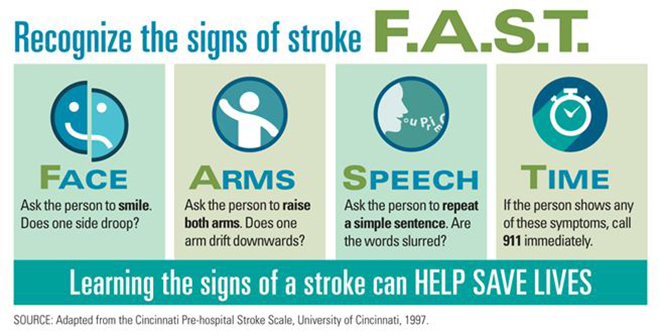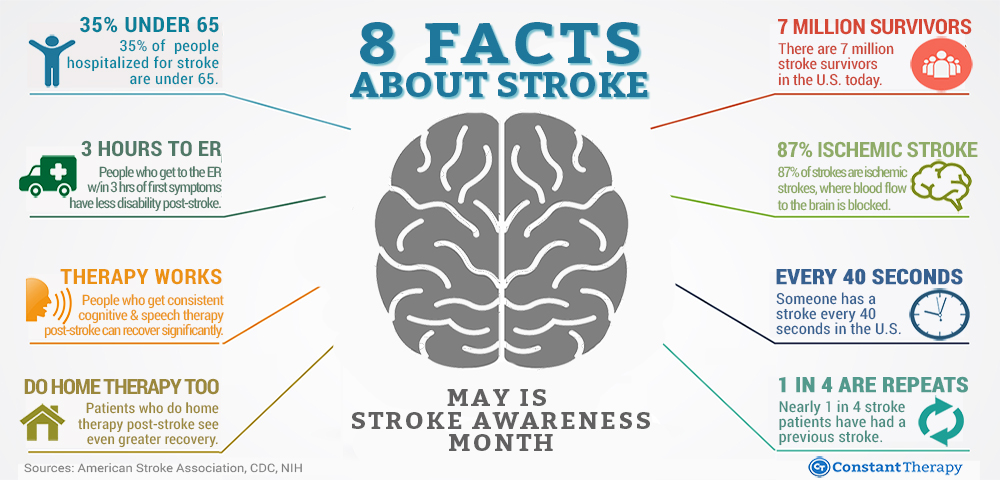
Even though strokes are the leading cause of long-term adult disability and a leading cause of death in the US, 80% of strokes could be preventable, according to the Centers for Disease Control (CDC).
Arm yourself and those you love with the knowledge about how to prevent stroke and how to react F.A.S.T. when someone is having one—because every minute counts!
What is a stroke?
89% of strokes in the US are ischemic strokes, occurring when a blood vessel that carries oxygen and nutrients to the brain is blocked by a clot.
Hemorrhagic strokes are when a blood vessel bursts and part of the brain is flooded with blood.
Both types of stroke damage brain tissue. The brain is a complex organ that controls many functions of your body and mind, so when a region that controls a particular function is damaged, that part of the body or mind won’t work as it should. Some people lose the ability to speak or think easily, others lose the ability to move one side of their body or move in a coordinated way.
Who is at risk to have a stroke?
While stroke risk increases with age, strokes can—and do—occur at any age. Strokes in young and middle-aged people are on the rise, and 35% of people currently hospitalized for stroke are less than 65 years old.
The most significant risk factor for strokes is high blood pressure, but high cholesterol, obesity, and smoking also contribute. The good news is behavioral or lifestyle changes and some medications can help reduce all of these risks.
Recognize and react – F.A.S.T.
Strokes may happen suddenly or slowly over a few hours. The person having a stroke may not recognize it, especially with a transient ischemic attack (TIA) or “mini-stroke” that can last only five minutes — but often precedes a major stroke by hours or days.
Every minute counts towards preventing lifelong disability or death! People who get to the ER within 3 hours of showing the first stroke symptoms experience fewer resulting disabilities.
Symptoms you may recognize if you are having a stroke are muscle weakness or numbness in part of your face or body, difficulty speaking, sudden confusion or trouble seeing out of one eye or double vision, headache, dizziness or nausea.

Stroke prevention
Embracing a diet that includes vegetables, low-salt foods, and committing to daily activity can help prevent many leading causes of death and serious illness, including stroke. However, if you are like most, you or someone in your family may still have some changes to make. Learn more about what you can do at the American Stroke Association.
4 behaviors that contribute to a high stroke risk
1: Eating an Unhealthy Diet
Diets high in saturated fats, trans fat, and cholesterol have been linked to stroke, and too much salt (sodium) in your diet can raise your blood pressure levels.
2: Not Being Physically Active on a Regular Basis
Physical inactivity can lead to health conditions that raise your risk for stroke — including obesity, high blood pressure, high cholesterol, and diabetes. Even two or three fifteen minute walks every day can make a significant difference in your health outcomes. At Cheshire, if your doctor recommends more physical activity, ask about our Prescribe for Health – Activity Is Good Medicine partnership with Keene YMCA.
3: Drinking Too Much Alcohol
More than 1 drink of alcohol a day for women, or 2 for men, can raise blood pressure levels and your risk for stroke. It also increases levels of triglycerides, a form of fat in your blood that can harden the arteries that deliver blood to your brain. If you need support with alcohol or any substance misuse, call 211.
4: Using or being exposed to Tobacco
Smoking—or breathing secondhand smoke—increases your risk for stroke because it can damage your heart and blood vessels. The nicotine in cigarettes raises blood pressure, and the carbon monoxide from cigarette smoke reduces the amount of oxygen that your blood can carry. If you need support to stop smoking call 1-800-QUIT-NOW.
After a stroke
Cheshire Medical Center’s Acute Inpatient Rehabilitation Unit helps patients in our region on their journey of recovering from a stroke. Each patient benefits from a team of specialists, therapists, and rehabilitation nurses assembled to meet their specific needs and at least three hours of occupational, physical, speech and recreational therapy each day. If needed, members of our Behavioral Health Team are available to help patients and families adjust. A social worker also helps coordinate services needed for the patient’s safe return home to their community, when possible.
Sometimes stroke survivors face lasting disabilities that require family members to become caretakers—a role that can be complex and challenging. There are many local and national resources available to help caregivers get the support they need. And don’t forget that making time for self-care is essential to everyone’s wellbeing as well.
While serious, and often life-changing, there is hope that most strokes are preventable, treatable, and beatable—as long as we help educate and support each other on how to prevent, recognize and react.
For more information:
